|
Chariots
by Bette Largent
|
|
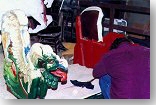
The carved side of a chariot before restoration
|
It's time to restore and repaint the chariots on Spokane's 1909
Looff carousel. An examination shows that
the
top of the head of each chariot's dragon is extremely worn and damaged. The older
teenage riders as well as adults use the head of the chariots as a foot rest
while they are riding the neighboring giraffe or tiger.
For one chariot the
problem is addressed by placing a metal stirrup on the pole of the giraffe.
Because the other chariot is placed next to the sneaky tiger,
a stirrup was not an option. We will have to solve the problem by
maintaining the clear coats and paint to protect the wood and carvings
underneath.
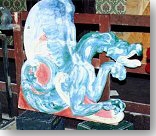
The carved side of a chariot during restoration
|
The
inside of each chariot will be finished in a faux finish that matches the
upholstery material. This will add continuity to the piece and will make it
much easier to touch up any new scratches and worn paint. A base color of red
enamel is applied and once dry, a deep brown-black stain is applied. This very
thin stain is then dabbed with ordinary wads of newspaper while still wet.
Due
to its size, it is done in sections as you have to work quickly. The final
result is a perfect match to the red cordovan leather material.
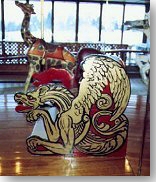
The flat side of a chariot with its 70's
paint job, and the unrestored giraffe in the background
|
The
next section to be tackled in the flat side of the chariots. Painted in the
seventies with gold metallic paint and black outlines, it did not match the
beauty of it's carved twin. It was painted and shaded to match the image on
the carved side. This will be reflected in the surround mirrors as the ride is
twirling.
The completed
chariot components all received 2 coats of clear polyurethane. The top edges
and the heads, alias foot rests, received four coats.
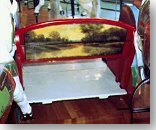
Chariot scenery panel, with its original paint covered
with yellowed varnish
|
The
scenery panels on the backs were discolored and chipped and had paint
splatters from previous paint jobs. They were, however, the original paintings
and would be cleaned and preserved. A black, chipped rod ran across the back
which stabilized the top of the chariot sides. This would be sleeved in brass.
At one point, someone had repainted this rod and slopped a black stripe of
paint completely across the painting behind it.

Chariot scenery panel, all cleaned up and as good as new!
|
By
removing the old, yellowed varnish and paint spots the bright colors were
revealed. This is the most tedious step of the restoration process.
Considering the age of the carousel, the varnish probably was not applied
until years after the carousel was created. It was not as dark as the aged
varnish on other pieces on the carousel prior to restoration. It may have been
painted on to preserve the paintings.
The removal of this varnish layer must
be done inch by inch in order to not damage the painting underneath with the
special solvents. Once cleaned, a method called in-painting is done where
necessary after filling in chips and gouges. This brings back the paintings to
their original beauty. Each had been outlined by a distorted black line. A
frame of painted gold braid and ornamentation is added which brings attention
to their existence. This coupled with the new brass sleeve makes them even
more attractive and noticeable.
Removing the upholstery from the seat panel proved to be the most
interesting. Five layers of vinyl or plastic was removed. It was like going
through the history of this synthetic material. There was the burgundy red of
the fake cordovan layer of the 70's, the bright red marbleized layer of the
40's and 50's found on every chrome diner stool and the more primitive plastic
of the 30's. The last layer was black oil cloth, the original covering of
1909. Under this was a white muslin top and a pad made up of long, carving
slivers of elm which were the thickness and length of straw.
Below this layer was a curved muslin pillow stuffed
with smaller wood chips. They had recycled the most abundant waste material
they had on hand...wood! The pillow cushion was still usable. We simply shook
it out and redistributed the chips to the original shape. We then covered it
with 4" of modern foam and found new upholstery material that perfectly matched
the sides. Samples of the previous materials were saved for our growing
collection of historical material.
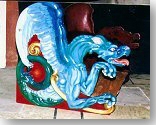
The Completed Dragon Chariot
|
The
new floor boards were adjusted to allow for the modern day wood measurements.
When the carousel was originally constructed a 1 X 12 was actually one inch by
twelve inches. They are then sanded and finished with several coats of
hard-wood floor finish. The chariots were then reassembled and placed back on
the carousel. This was done just in time for the grandparents of the bride and
groom to ride in after a beautiful evening wedding in the Spokane Looff
Wedding Carousel.
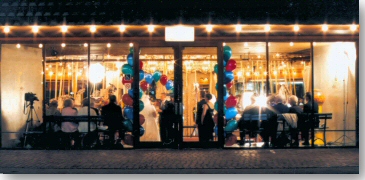 An Evening Wedding at the Spokane Looff Wedding Carousel
An Evening Wedding at the Spokane Looff Wedding Carousel
|
Bette Largent is a professional carousel horse restoration artist from
Washington State, and the author of
Paint The Ponies,
a guide for those who are interested in learning the art of painting
carousel figures.
Click
Here
for information on ordering her book.
|
|

